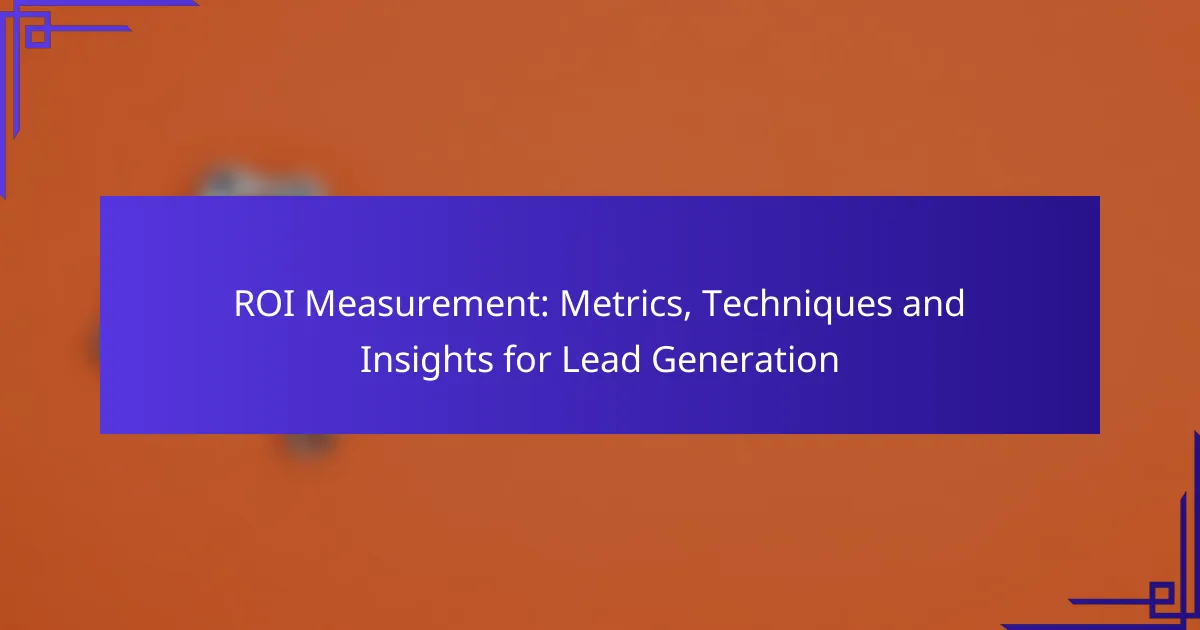Measuring ROI in lead generation is crucial for understanding the effectiveness of your marketing efforts. Key metrics such as Customer Acquisition Cost, Lifetime Value, and Conversion Rate provide valuable insights that guide strategic decisions. By leveraging technology and systematic approaches, businesses can enhance their measurement techniques and overcome common challenges in data integration and attribution. This ensures a more accurate assessment of marketing performance and lead quality.
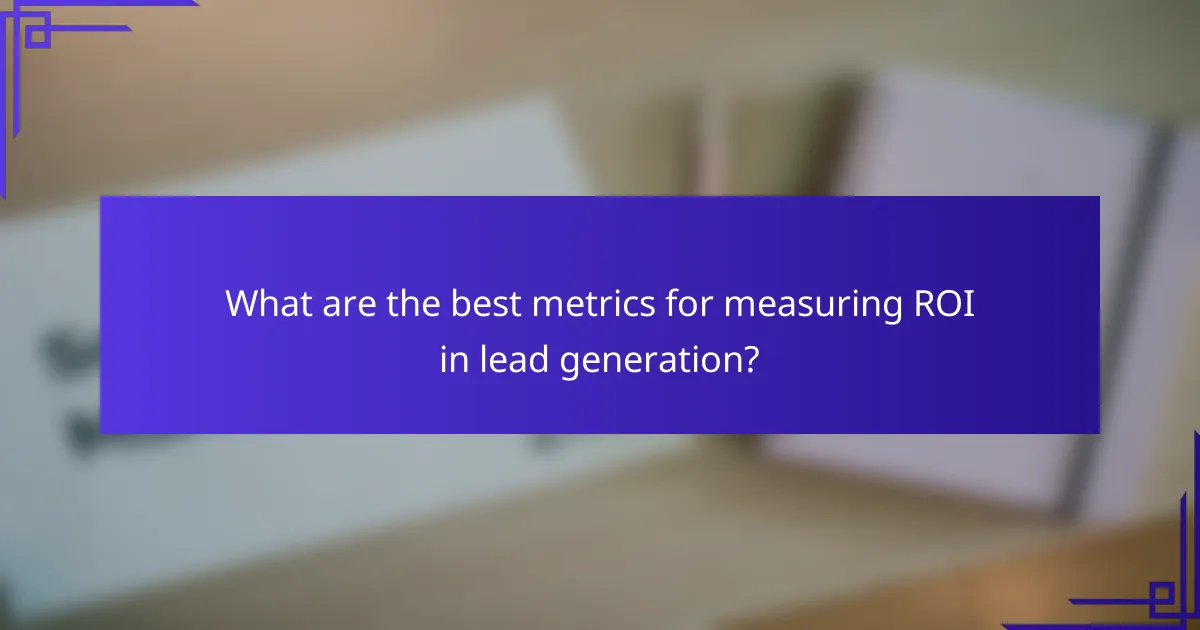
What are the best metrics for measuring ROI in lead generation?
The best metrics for measuring ROI in lead generation include Customer Acquisition Cost (CAC), Lifetime Value (LTV), Conversion Rate, Return on Advertising Spend (ROAS), and Lead-to-Customer Rate. These metrics provide insights into the effectiveness and efficiency of your lead generation efforts, helping you make informed decisions to optimize your marketing strategy.
Customer Acquisition Cost (CAC)
Customer Acquisition Cost (CAC) measures the total cost of acquiring a new customer, including marketing expenses, sales costs, and any other related expenditures. To calculate CAC, divide the total costs associated with acquiring customers over a specific period by the number of customers gained in that same period.
A lower CAC indicates a more efficient lead generation strategy. Aim for a CAC that is significantly lower than the Lifetime Value (LTV) of your customers to ensure profitability. For many businesses, a CAC that is one-third of the LTV is a good benchmark.
Lifetime Value (LTV)
Lifetime Value (LTV) estimates the total revenue a business can expect from a customer throughout their relationship. This metric helps you understand how much you can invest in acquiring new customers while maintaining profitability.
To calculate LTV, multiply the average purchase value by the average purchase frequency and the average customer lifespan. For example, if a customer spends $100 per purchase, buys four times a year, and stays for five years, the LTV would be $2,000. A higher LTV compared to CAC is essential for a sustainable business model.
Conversion Rate
The conversion rate measures the percentage of leads that become paying customers. This metric is crucial for evaluating the effectiveness of your lead generation efforts and sales processes. To calculate the conversion rate, divide the number of conversions by the total number of leads, then multiply by 100.
For example, if you generated 1,000 leads and 100 of them converted into customers, your conversion rate would be 10%. A higher conversion rate indicates a more effective sales funnel, while a low rate may signal the need for improvements in your lead nurturing strategies.
Return on Advertising Spend (ROAS)
Return on Advertising Spend (ROAS) measures the revenue generated for every dollar spent on advertising. This metric helps assess the effectiveness of your advertising campaigns in generating leads and sales. To calculate ROAS, divide the total revenue generated from ads by the total ad spend.
A ROAS of 4:1, meaning $4 earned for every $1 spent, is often considered a good target. However, this can vary by industry and campaign goals. Regularly analyzing ROAS can help you allocate your advertising budget more effectively and identify underperforming campaigns.
Lead-to-Customer Rate
The Lead-to-Customer Rate indicates the percentage of leads that successfully convert into customers. This metric is vital for understanding the effectiveness of your lead generation and sales processes. To calculate this rate, divide the number of customers acquired by the total number of leads generated, then multiply by 100.
For instance, if you have 500 leads and 50 of them become customers, your Lead-to-Customer Rate is 10%. Monitoring this rate can help identify areas for improvement in your sales tactics and lead qualification processes, ultimately enhancing your overall ROI in lead generation.
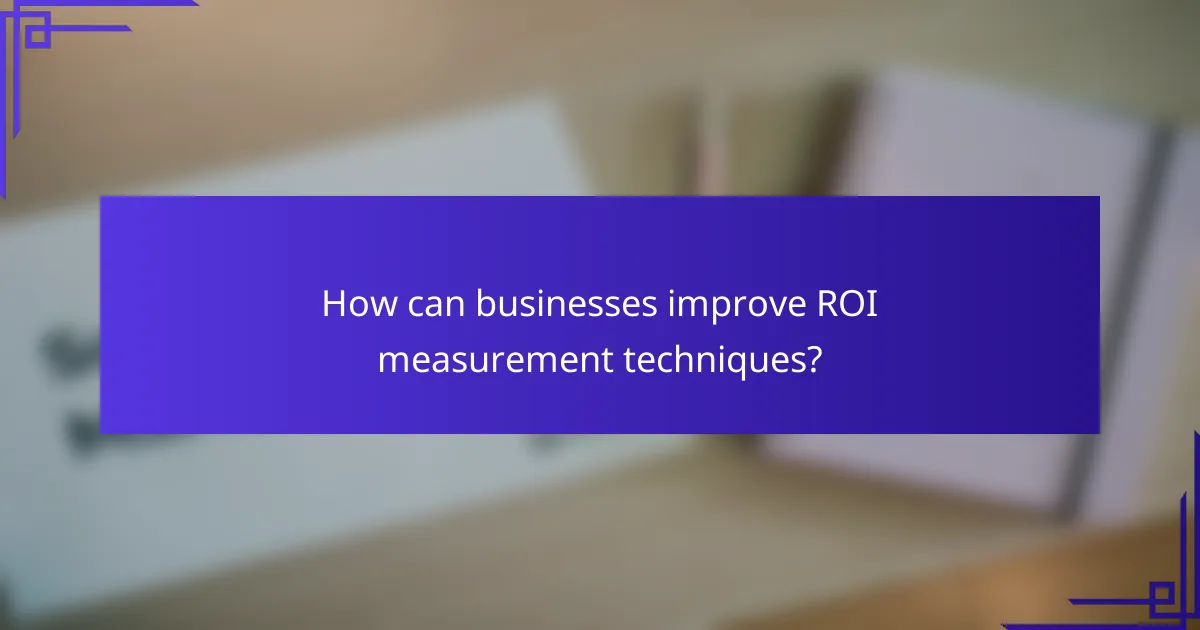
How can businesses improve ROI measurement techniques?
Businesses can enhance ROI measurement techniques by adopting systematic approaches that leverage technology and data analysis. Key strategies include implementing marketing automation tools, utilizing CRM software, and conducting A/B testing to refine marketing efforts.
Implementing Marketing Automation Tools
Marketing automation tools streamline processes and help track the effectiveness of campaigns, making it easier to measure ROI. These platforms can automate tasks such as email marketing, social media posting, and lead nurturing, allowing businesses to focus on strategy rather than repetitive tasks.
When selecting a marketing automation tool, consider features like analytics dashboards, integration capabilities with existing systems, and user-friendliness. Popular options include HubSpot, Marketo, and Mailchimp, each offering various pricing tiers to fit different budgets.
Utilizing CRM Software like HubSpot
CRM software, such as HubSpot, plays a crucial role in measuring ROI by centralizing customer data and tracking interactions. This enables businesses to analyze customer behavior and assess the effectiveness of their marketing strategies over time.
To maximize ROI measurement with CRM, ensure that your team is trained to use the software effectively. Regularly update customer records and utilize reporting features to gain insights into conversion rates and customer lifetime value, which are essential for understanding overall ROI.
Conducting A/B Testing
A/B testing involves comparing two versions of a marketing asset to determine which performs better in terms of ROI. This technique allows businesses to make data-driven decisions by testing variations in email subject lines, landing pages, or ad copy.
To conduct effective A/B tests, define clear objectives and metrics for success, such as click-through rates or conversion rates. Run tests over a sufficient duration to gather meaningful data, and avoid making changes based on short-term results to ensure reliable insights.
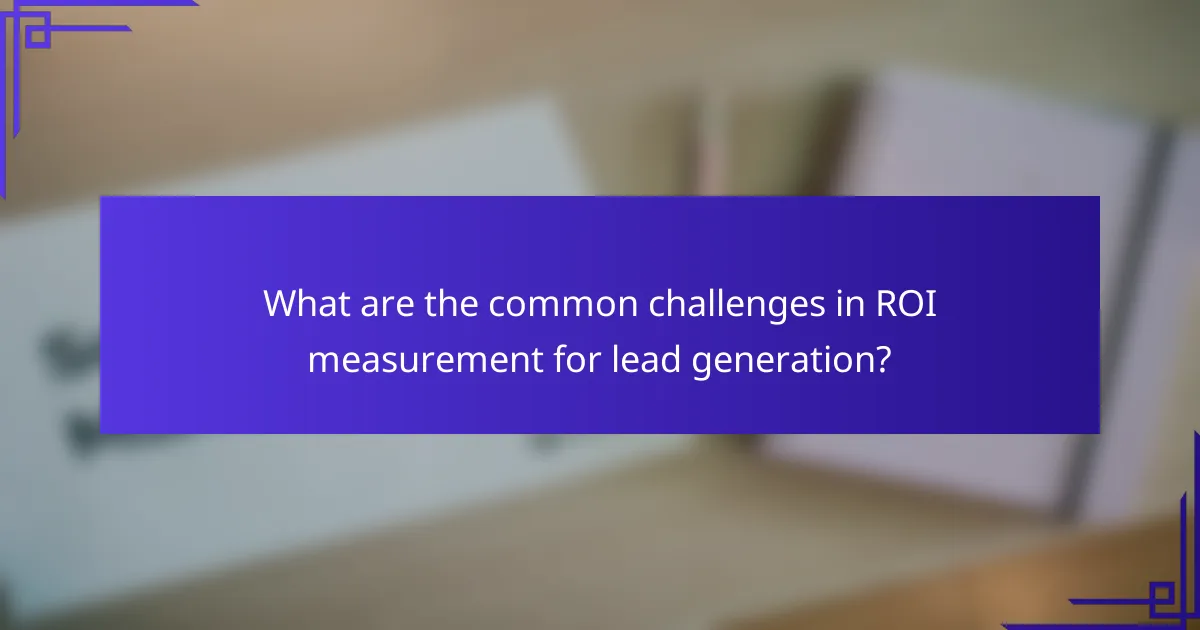
What are the common challenges in ROI measurement for lead generation?
Common challenges in ROI measurement for lead generation include data integration issues, the complexity of attribution models, and insufficient tracking mechanisms. These obstacles can hinder accurate assessments of marketing effectiveness and lead quality.
Data Integration Issues
Data integration issues arise when organizations struggle to consolidate information from various sources, such as CRM systems, marketing automation tools, and analytics platforms. This fragmentation can lead to incomplete or inaccurate data, making it difficult to assess the true ROI of lead generation efforts.
To mitigate these issues, businesses should invest in robust data management solutions that facilitate seamless integration. Regular audits of data sources and processes can also help identify gaps and improve overall accuracy.
Attribution Model Complexity
The complexity of attribution models presents a significant challenge in measuring ROI for lead generation. With multiple touchpoints in a customer’s journey, determining which channels contribute most effectively to conversions can be difficult.
Organizations should consider adopting multi-touch attribution models that provide a more comprehensive view of customer interactions. Simplifying the model or focusing on a few key channels can also help streamline analysis and improve decision-making.
Insufficient Tracking Mechanisms
Insufficient tracking mechanisms can lead to missed opportunities in understanding lead performance and ROI. Without proper tracking, businesses may not capture essential data points, resulting in a lack of insights into which strategies are working.
Implementing comprehensive tracking solutions, such as UTM parameters and conversion tracking, is crucial. Regularly reviewing and updating tracking methods ensures that all relevant data is captured, enabling more informed marketing decisions.

What frameworks can help in evaluating lead generation ROI?
Several frameworks can effectively evaluate lead generation ROI, focusing on analyzing customer interactions and their impact on revenue. These frameworks help marketers understand the efficiency of their lead generation efforts and optimize strategies for better returns.
Marketing Funnel Analysis
Marketing funnel analysis breaks down the customer journey into stages, from awareness to conversion. By assessing the performance at each stage, businesses can identify where leads drop off and optimize those areas to improve overall ROI.
For example, if a significant number of leads are lost during the consideration phase, it may indicate a need for better content or engagement strategies. Tracking metrics like conversion rates and average time spent at each stage can provide actionable insights.
Multi-Touch Attribution Models
Multi-touch attribution models assign value to each touchpoint in the customer journey, providing a more comprehensive view of how different channels contribute to lead generation. This approach helps marketers understand which strategies are most effective in driving conversions.
Common models include linear attribution, which evenly distributes credit across all touchpoints, and time decay attribution, which gives more weight to interactions closer to the conversion. Choosing the right model depends on your business goals and the complexity of your customer interactions.

What advanced techniques can enhance ROI insights?
Advanced techniques such as predictive analytics and customer segmentation strategies can significantly enhance ROI insights for lead generation. These methods allow businesses to better understand their data, identify trends, and tailor their marketing efforts for improved outcomes.
Predictive Analytics
Predictive analytics uses historical data and statistical algorithms to forecast future outcomes. By analyzing past lead generation efforts, businesses can identify which strategies are most likely to yield high ROI. For instance, if a certain type of content consistently attracts qualified leads, resources can be allocated to produce more of that content.
To implement predictive analytics effectively, companies should focus on collecting quality data and utilizing appropriate software tools. Common pitfalls include relying on incomplete data or failing to regularly update predictive models, which can lead to inaccurate forecasts. A good practice is to review and adjust models quarterly to reflect changing market conditions.
Customer Segmentation Strategies
Customer segmentation involves dividing a customer base into distinct groups based on shared characteristics. This allows businesses to tailor their marketing efforts to specific segments, enhancing the effectiveness of lead generation campaigns. For example, targeting high-value customers with personalized offers can lead to significantly higher conversion rates.
When developing segmentation strategies, consider factors such as demographics, purchasing behavior, and engagement levels. It’s essential to avoid overly broad segments, as this can dilute marketing efforts. Instead, aim for smaller, more defined groups that allow for targeted messaging. Regularly reassess segments to ensure they remain relevant as customer preferences evolve.
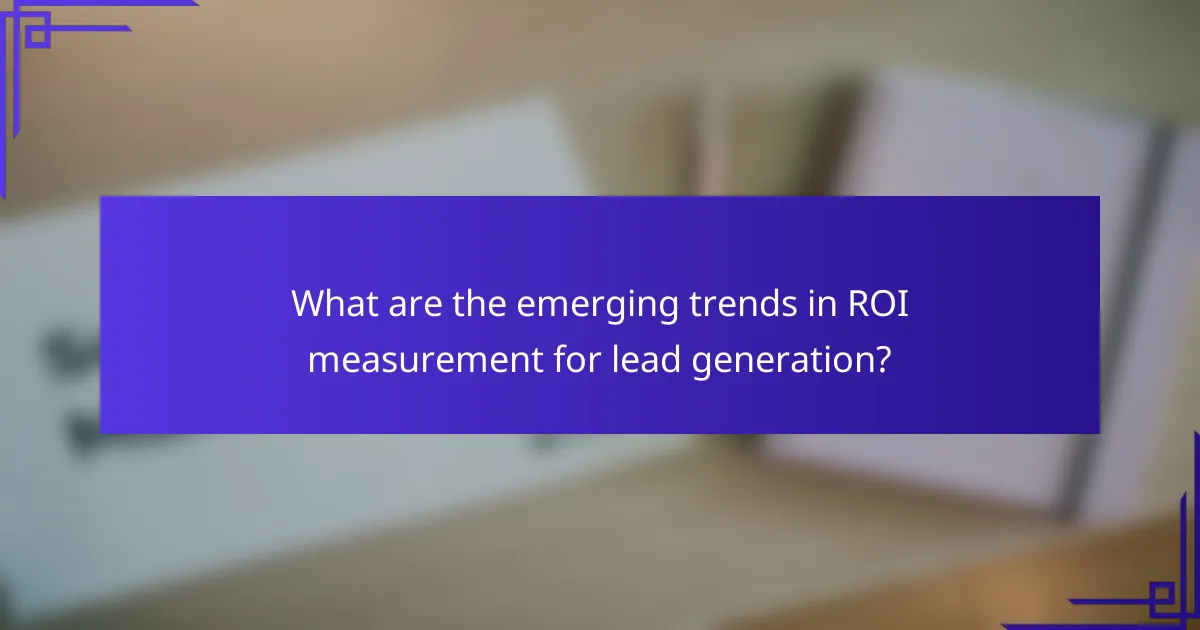
What are the emerging trends in ROI measurement for lead generation?
Emerging trends in ROI measurement for lead generation focus on leveraging advanced analytics, automation, and real-time data to enhance decision-making. Businesses are increasingly adopting multi-channel attribution models and predictive analytics to better understand the effectiveness of their lead generation efforts.
Integration of AI and Machine Learning
The integration of AI and machine learning in ROI measurement allows businesses to analyze vast amounts of data quickly and accurately. These technologies can identify patterns and predict outcomes, enabling marketers to optimize their lead generation strategies based on data-driven insights.
For example, AI can help determine which channels yield the highest conversion rates, allowing businesses to allocate resources more effectively. Companies may see improvements in lead quality and reduced acquisition costs by focusing on high-performing channels.
Emphasis on Multi-Channel Attribution
Multi-channel attribution is gaining traction as businesses recognize that customers often interact with multiple touchpoints before converting. This approach helps marketers understand the contribution of each channel to the overall lead generation process.
Implementing multi-channel attribution requires tracking tools and analytics platforms that can provide insights into customer journeys. By analyzing these interactions, companies can refine their strategies and invest in the most effective channels, ultimately improving ROI.
Real-Time Data Analytics
Real-time data analytics is becoming essential for measuring ROI in lead generation. Access to up-to-the-minute data allows marketers to make informed decisions and adjust campaigns on the fly, enhancing responsiveness to market changes.
For instance, if a particular campaign is underperforming, real-time analytics can highlight the issue, enabling quick adjustments to improve results. This agility can lead to better lead conversion rates and a more efficient allocation of marketing budgets.
Focus on Customer Lifetime Value (CLV)
Measuring ROI through the lens of Customer Lifetime Value (CLV) is increasingly important. CLV provides a long-term perspective on the value generated from each lead, rather than just immediate returns.
By focusing on CLV, businesses can identify high-value leads and tailor their marketing efforts accordingly. This approach encourages investment in nurturing relationships with leads, which can lead to higher retention rates and increased profitability over time.
